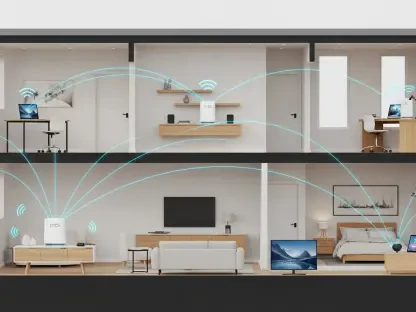Setting the Stage: A Digital Divide in Germany’s Telecom Sector
In the heart of Europe’s largest economy, a perplexing challenge unfolds as Deutsche Telekom (DT), Germany’s leading telecommunications provider, races to build a robust fiber optic network, only to face stubbornly low customer adoption. Despite passing an impressive 11.8 million premises with fiber connectivity, the uptake rate lingers at a mere 16.1%, far below the company’s ambitious targets. This discrepancy between infrastructure investment and market response raises critical questions about the future of digital connectivity in Germany. The analysis that follows delves into the telecom giant’s current market position, dissects the underlying trends driving adoption woes, and explores strategic maneuvers aimed at bridging this gap, offering a comprehensive look at what lies ahead for DT and the broader industry.
Unpacking Market Dynamics: Fiber Expansion versus Customer Uptake
Infrastructure Growth Outpaces Demand: A Stark Contrast
Deutsche Telekom has made significant strides in expanding its fiber optic footprint, adding 1.7 million premises to its network in the first nine months of the current year, reaching a total of 11.8 million. This achievement reflects a massive capital commitment to modernize Germany’s internet backbone, long criticized for relying on outdated copper lines compared to other European nations. However, the penetration rate, inching up from 14.6% last year to 16.1% now, underscores a troubling reality: availability does not guarantee adoption. This gap highlights a deeper market issue where consumer behavior and awareness lag behind technological advancements, posing a risk to the return on investment for such extensive buildouts.
Economic and Competitive Pressures: A Tough Domestic Landscape
The German telecom market presents additional hurdles for DT, with a sluggish domestic economy impacting demand, particularly in the business-to-business segment. Financial results for the third quarter reveal a solid performance on paper—net revenues grew organically by 3.3% to $33.6 billion, and adjusted EBITDAaL rose 2.9% to $12.9 billion—but underlying challenges persist. Intense competition from alternative network operators erodes pricing power, while macroeconomic factors such as a weaker dollar, rising salaries, and elevated energy costs squeeze margins. These conditions create a complex environment where DT must navigate cost pressures while sustaining its capital-intensive fiber rollout, a balancing act that shapes its market strategy.
Consumer Hesitation: Barriers Beyond Infrastructure
Beyond economic factors, consumer reluctance plays a pivotal role in stunting fiber adoption. Many households and businesses remain unaware of the benefits of fiber over traditional connections, or they balk at potential installation disruptions and costs. In multi-dwelling units, logistical challenges, such as securing landlord approvals for pre-connecting properties, further complicate uptake. This hesitancy reflects a broader cultural and informational barrier in the market, where the perceived value of high-speed internet has not yet aligned with the infrastructure push. Addressing this disconnect emerges as a critical focus for turning infrastructure investments into active subscriptions.
Strategic Responses: Adapting to Market Realities
Refining Buildout Priorities: Targeting High-Demand Zones
In response to sluggish uptake, DT is recalibrating its deployment approach by prioritizing single-family housing units, where adoption rates show greater promise compared to multi-dwelling units. This targeted strategy aims to optimize financial returns by focusing on areas with higher demand potential, a pragmatic shift given the current 16.1% penetration rate against a 20% goal set for 2027. However, complexities in multi-dwelling environments persist, with cumbersome approval processes slowing progress. DT’s stance on not absorbing extra costs for individual connections signals a push for shared responsibility among stakeholders, a move that could streamline efforts but risks friction with property owners.
Financial Maneuvers: Pricing Adjustments amid Cost Challenges
Financially, DT is grappling with the dual need to fund its fiber ambitions and maintain profitability in a competitive market. The decision to raise prices to boost revenue per connection represents a calculated risk, potentially alienating price-sensitive customers but necessary to offset the high costs of network expansion. With economic headwinds like rising operational expenses impacting EBITDA, this pricing strategy seeks to stabilize revenue streams. The interplay between cost management and customer retention will be crucial in determining whether DT can sustain its growth trajectory without sacrificing market share to leaner competitors.
Leveraging Innovation: AI and Partnerships as Market Differentiators
Technological innovation offers a lifeline for DT in addressing market challenges, with AI-driven efficiencies slashing fiber capital expenditure by 9% through techniques like shallow digging and process industrialization. Projected savings of $930 million by 2027 in non-US markets underscore the transformative potential of such tools in a cost-heavy industry. Additionally, partnerships with global tech leaders like Nvidia help tackle infrastructure sovereignty concerns, even as the absence of strong European alternatives remains a sticking point. These advancements position DT to enhance operational agility, a competitive edge in a market where efficiency can translate into broader coverage and better pricing.
Future Projections: Trends Shaping Telecom Infrastructure
Regulatory and Policy Impacts: A Call for Supportive Frameworks
Looking ahead, the telecom sector in Germany stands at a crossroads influenced heavily by regulatory developments. Potential tightening of rules on high-risk vendors could reshape equipment sourcing strategies, even as DT maintains a cautious approach by excluding certain providers from core networks while minimizing concerns in peripheral systems. A louder call for government intervention to mandate fiber use or simplify approval processes reflects an industry-wide need for policy alignment. Such frameworks could catalyze adoption rates, turning current barriers into opportunities for market expansion if policymakers respond with actionable measures.
Expansion Goals and Digital Equity: Bridging Rural-Urban Gaps
DT’s ambitious target of passing an additional 2.5 million premises annually, including in rural areas, aligns with a growing emphasis on digital equity across Europe. This focus on underserved regions addresses a critical market gap, as rural connectivity often lags behind urban centers, exacerbating the digital divide. Success in these areas could bolster overall adoption metrics, but it demands sustained investment and innovative deployment methods. The trend toward inclusive connectivity suggests that future market growth may hinge on balancing profitability with social impact, a challenge for all major telecom players.
Technological Horizons: AI and Open Networks as Game-Changers
Emerging technological trends, particularly in AI optimization and open RAN collaborations with companies like Nokia, promise to redefine cost structures and flexibility in the telecom market. These advancements could lower barriers to entry for expansive projects, enabling faster rollouts at reduced expenses. As economic recovery remains uncertain, the ability to leverage such innovations will likely separate market leaders from laggards. Analysts anticipate that sustained integration of cutting-edge solutions will drive efficiency, potentially tipping the scales toward higher customer uptake if paired with effective demand-side initiatives.
Reflecting on the Journey: Strategic Takeaways for the Telecom Market
Looking back, the journey of Deutsche Telekom in navigating Germany’s fiber optic market reveals a landscape fraught with contradictions—massive infrastructure gains juxtaposed against tepid consumer response. The analysis highlights how economic constraints, competitive pressures, and cultural hesitancy shape a challenging environment, even as financial growth metrics show resilience. Strategic pivots toward high-demand areas, pricing adjustments, and AI-driven efficiencies stand out as adaptive responses to these hurdles. For the future, industry stakeholders should prioritize collaborative efforts, with telecom providers focusing on consumer education and bundled service offerings to stimulate demand. Governments, meanwhile, must consider regulatory incentives and streamlined processes to support adoption. As a next step, fostering public-private partnerships could unlock new pathways, ensuring that fiber becomes not just a network, but a cornerstone of digital progress in Germany.









